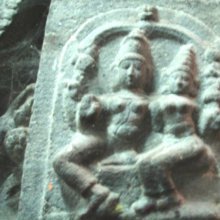Furious: 3 definitions
Introduction:
Furious means something in Hinduism, Sanskrit. If you want to know the exact meaning, history, etymology or English translation of this term then check out the descriptions on this page. Add your comment or reference to a book if you want to contribute to this summary article.
Images (photo gallery)
In Hinduism
Gitashastra (science of music)
Source: Shodhganga: Elements of Art and Architecture in the Trtiyakhanda of the Visnudharmottarapurana (gita)The Furious Sentiment (in Sanskrit: raudra-rasa) refers to one of the nine kinds of Sentiment (rasa) in Indian classical Music. They have an inherent relationship with the svaras (“musical notes”).—There are nine kinds of sentiments: [e.g., Furious (raudra)]. In the Nāṭyaśāstra some particular svaras are determined for the delineation of some specific sentiments. In the Nāṭyaśāstra it is accepted that—the notes ṣadja and ṛṣabha are used to delineate the sentiments of vīra, raudra and adbhuta.
Gitashastra (गीतशास्त्र, gītaśāstra) refers to the ancient Indian science of Music (gita or samgita), which is traditionally divided in Vocal music, Instrumental music and Dance (under the jurisdiction of music). The different elements and technical terms are explained in a wide range of (often Sanskrit) literature.
Natyashastra (theatrics and dramaturgy)
Source: Shodhganga: Elements of Art and Architecture in the Trtiyakhanda of the Visnudharmottarapurana (natya)1) The Furious Sentiment is denoted by the Sanskrit term Raudra-rasa, which represents one of the nine kinds of Rasa (“soul of Drama”), according to the Viṣṇudharmottarapurāṇa, an ancient Sanskrit text which (being encyclopedic in nature) deals with a variety of cultural topics such as arts, architecture, music, grammar and astronomy.—The Viṣṇudharmottarapurāṇa relates that raudra is the sentiment that arises from anger. Krodha is the sthāyibhāva of raudrarasa (the furious sentiment). Rakta i.e., red is the colour and Rudra is the God of this sentiment. According to the Viṣṇudharmottarapurāṇa anger is of four types. [...] The Viṣṇudharmottarapurāṇa again says that the facial expressions of anger viz., redness of eyes, cocked of eyebrows, face full of perspiration etc., should be used to project raudrarasa in performance
2) Furious things are associated with Maṇḍala: one of the “six kinds of Standing Postures for Men”.—Standing postures are determined separately for male and female. In the Viṣṇudharmottarapurāṇa six kinds of standing postures are discussed for men. The Śabdakalpadruma states that in āliḍha posture the right leg should be extended and the left leg should be contracted. This position is used to denote furious things as well as taken at the time of fighting.

Natyashastra (नाट्यशास्त्र, nāṭyaśāstra) refers to both the ancient Indian tradition (shastra) of performing arts, (natya—theatrics, drama, dance, music), as well as the name of a Sanskrit work dealing with these subjects. It also teaches the rules for composing Dramatic plays (nataka), construction and performance of Theater, and Poetic works (kavya).
Shilpashastra (iconography)
Source: Shodhganga: Elements of Art and Architecture in the Trtiyakhanda of the Visnudharmottarapurana (shilpa)The Furious (sentiment) refers to one of the Nine Sentiments (citrarasa) in ancient Indian Painting (citra), according to the Viṣṇudharmottarapurāṇa, an ancient Sanskrit text which (being encyclopedic in nature) deals with a variety of cultural topics such as arts, architecture, music, grammar and astronomy.—Painting is a medium of showing the inner feelings and emotions of a painter which can strikes the inherent sentiments of connoisseur’s mind [e.g., the furious sentiment (raudra)]. [...] According to the Viṣṇudharmottarapurāṇa, the raudrarasa is delineated with harshness, passion and anger in a picture. Moreover, to draw a picture which reflects raudrarasa, the painter should paint flashing weapons and bright ornaments.

Shilpashastra (शिल्पशास्त्र, śilpaśāstra) represents the ancient Indian science (shastra) of creative arts (shilpa) such as sculpture, iconography and painting. Closely related to Vastushastra (architecture), they often share the same literature.
See also (Relevant definitions)
Full-text (+647): Kopakula, Madavikshipta, Madotkata, Roshin, Ranatumbala, Tumula, Bhadamara, Raudra, Dharata, Thadada, Khavisa, Dhadaphada, Dhadabada, Khanajangi, Dendera, Ranamatta, Madakala, Raudrarasa, Matta, Hatthippabhinna.
Relevant text
Search found 122 books and stories containing Furious; (plurals include: Furiouses). You can also click to the full overview containing English textual excerpts. Below are direct links for the most relevant articles:
Dasarupaka (critical study) (by Anuru Ranjan Mishra)
Part 9 - Sentiments (rasa) used in a Ḍima < [Chapter 4 - Ḍima (critical study)]
Part 9 - Sentiments (rasa) used in a Vyāyoga < [Chapter 5 - Vyāyoga (critical study)]
Part 9 - Sentiments (rasa) used in a Nāṭaka < [Chapter 1 - Nāṭaka (critical study)]
Garga Samhita (English) (by Danavir Goswami)
Verse 3.2.5 < [Chapter 2 - The Great Festival of Śrī Girirāja]
Verses 1.7.42-45 < [Chapter 7 - Description of the Conquest of All Directions]
Verse 3.2.24 < [Chapter 2 - The Great Festival of Śrī Girirāja]
The Shiva Purana (by J. L. Shastri)
Chapter 26 - The cause of estrangement between Dakṣa and Śiva < [Section 2.2 - Rudra-saṃhitā (2): Satī-khaṇḍa]
Chapter 30 - The incarnation of Śiva as Avadhūteśvara < [Section 3 - Śatarudra-saṃhitā]
Chapter 8 - The battle between the gods and Asuras < [Section 2.4 - Rudra-saṃhitā (4): Kumāra-khaṇḍa]
Natyashastra (English) (by Bharata-muni)
Chapter VI - Sentiments (rasa)
Chapter XIX - Modes of Address (nāman) and Intonation (kāku)
Malatimadhava (study) (by Jintu Moni Dutta)
Part 1.3c - Raudra Rasa (The Furious Sentiment) < [Chapter 2 - Literary Study of the Mālatīmādhava]
Part 1.2 - Types of Rasa < [Chapter 2 - Literary Study of the Mālatīmādhava]
Part 3.3b - Gauḍī Rīti < [Chapter 2 - Literary Study of the Mālatīmādhava]
Dramaturgy in the Venisamhara (by Debi Prasad Namasudra)
The Relationship of the different phases of Rasas < [Chapter 4 - Dramaturgy in Veṇīsaṃhāra]
Description of Ḍima < [Chapter 2 - Nature and Classification of Sanskrit Drama]
Ārabhaṭī-vṛtti (fierce fights and outrageous deeds) < [Chapter 4 - Dramaturgy in Veṇīsaṃhāra]
